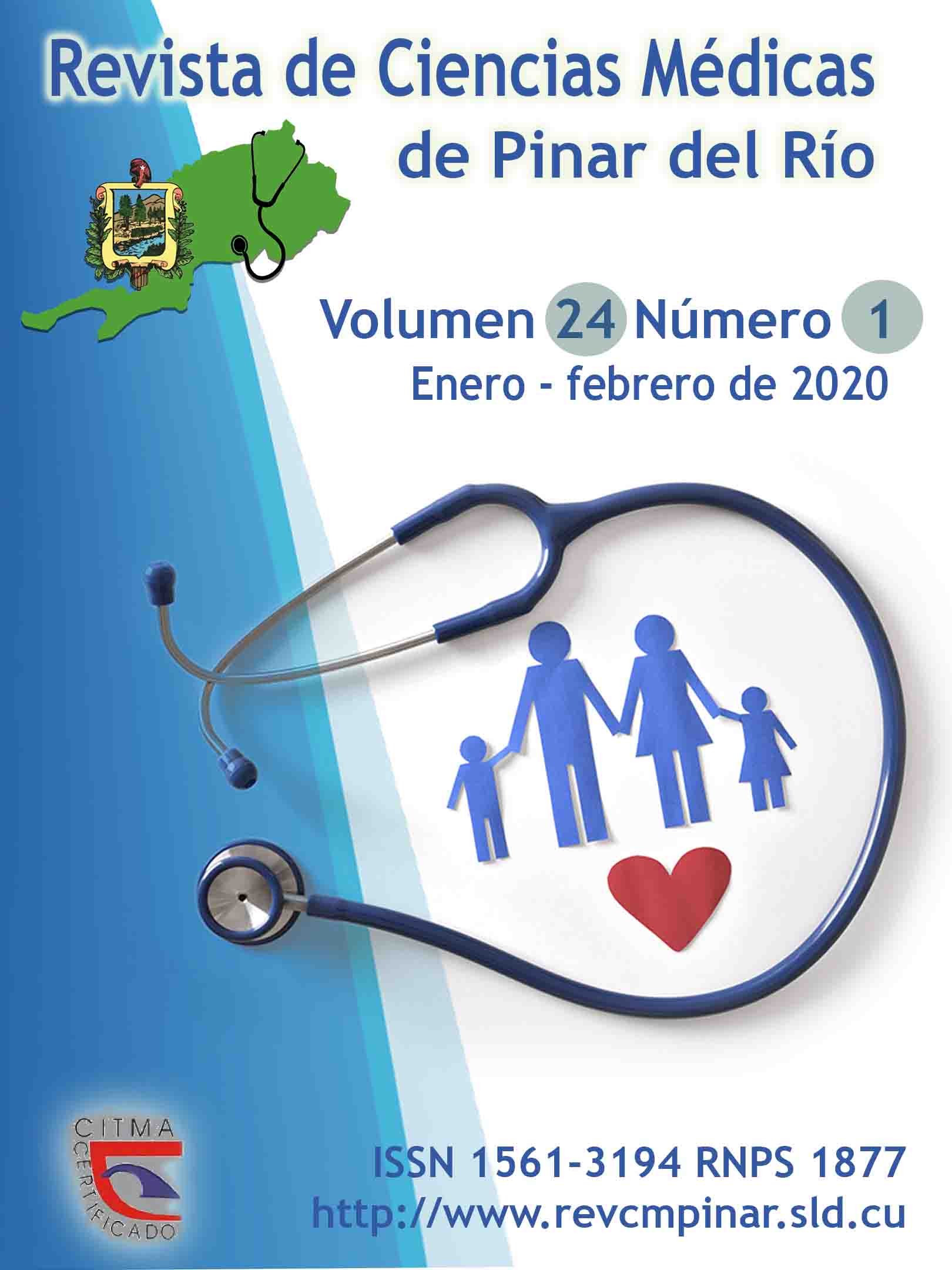Mental maps and mobile learning devices for the management of independent work in morphology-physiology subject
Keywords:
MIND MAPS, MOBILE LEARNING, INDEPENDENT WORK, GUIDANCE OF INDEPENDENT WORK, MEANINGFUL LEARNING, COLLABORATIVE LEARNING.Abstract
Introduction: in these times, learning and teaching implies adopting non-traditional models and promoting ways to access to knowledge, in which the development of mobile learning devices lead to the appearance of new models and methodologies for the presentation of learning contents.
Objective: to show how the creation of mental maps in digital format allow students to synthesize, organize and graphically present support information for self-preparation during the implementation of independent work, as well as significant learning.
Development: the results correspond to a descriptive, longitudinal and prospective research and to the preliminary application of a strategy responding to the improvement of the management of independent work in the subject morphology-physiology in Dentistry Studies at Pinar del Rio University of Medical Sciences, which was made considering the possibilities that as a learning resource offers the application for Android, Mindomo, version 3.0.15 aimed at creating schemes and mental maps, which allowed to represent the contents of the subject free of the linear organization offered by the textbooks or materials that are part of the literature.
Conclusions: the schemes and mental maps created by means of mobile learning devices, allowed to synthesize, organize and graphically present to the students the support information for their self-preparation during the management of the independent work; it favored the integration of the contents of morphology and physiology, emphasizing its invariants, as well as to the significant and collaborative learning to solve the teaching tasks.
Downloads
References
1. Santos Ríos E, Vázquez Vázquez JM, Del Cristo Sosa Y. La dirección del trabajo independiente en el contexto universitario. Revista Caribeña de Ciencias Sociales [Internet]. 2017 [citado 05/04/2019]; 11(s/n): [aprox. 5 p.]. Disponible en: http://www.eumed.net/rev/caribe/2017/11/direccion-trabajo-independiente.html
2. Bastida Lugones L, Quintana M, Del Carmen E. La dirección educacional y la dirección en la escuela: sus especificidades. Revista Universidad y Sociedad [Internet]. 2017 [citado 15/05/2019]; 9(3): 34-38 Disponible en: http://scielo.sld.cu/scielo.php?script=sci_arttext&pid=S2218-36202017000300005
3. Albet Díaz JF, López Calichs E. Sistema de medios de enseñanza sobre tronco encefálico y dirección del trabajo independiente. Educ Med Super. [Internet]. 2014 [citado 03/05/2019]; 28(4): [aprox. 5 p.]. Disponible en: https://www.medigraphic.com/cgi-bin/new/resumen.cgi?IDARTICULO=58164
4. Flores Guerrero D, Fernández Sesma M G, Rodríguez Arroyo M A. La modalidad educativa Mobile Learning como facilitador del pensamiento crítico en la educación superior. Congreso Universidad. [Internet]. 2017 [citado 15/05/2019]; 6(6): [aprox. 18 p.]. Disponible en: http://www.congresouniversidad.cu/revista/index.php/congresouniversidad/index
5. Mateus JC, Aran Ramspott S, Masanet MJ. Análisis de la literatura sobre dispositivos móviles en la universidad española. RIED. Revista Iberoamericana de Educación a Distancia. [Internet]. 2017 [citado 29/04/2019]; 20(2): [aprox. 23 p.]. Disponible en: https://www.redalyc.org/pdf/3314/331453132003.pdf
6. Torres Díaz JC, Infante Moro A, Torres Carrión PV. Aprendizaje móvil: perspectivas. RUSC. Universities and Knowledge Society Journal. [Internet]. 2015 [citado 29/04/2019]; 12(1): 38-49. Disponible en:
https://www.redalyc.org/pdf/780/78033494005.pdf
7. Buzan T. El libro de los Mapas Mentales. Ediciones URANO. Madrid, España. 2000.
8. Hernández MS, Romero B. Mapas mentales como estrategia didáctica para el aprendizaje significativo en los estudiantes de primaria. Revista Arbitrada del CIEG [Internet]. 2015 [citado 29/04/2019]; s/v(23): 1-18. Disponible en: http://www.grupocieg.org/archivos_revista/Ed.%2023(1-18)-Hern%C3%A1ndez%20Mar%C3%ADa%20Soledad-Romero%20Bolivia%20(1)_articulo_id233.pdf
9. Lillo Zúñiga FG. Aprendizaje Colaborativo en la Formación Universitaria de Pregrado. Rev. Psicol. [Internet]. 2013 [citado 29/04/2019]; 2(4): 109-142. Disponible en: http://sitios.uvm.cl/revistapsicologia/revista/04.05.aprendizaje.pdf
10. Román Collazo CA, Hernández Rodríguez Y, Ortiz Rodríguez F, Alonso Gómez T M. La tarea extraclase desarrolladora como actividad docente potenciadora para el aprendizaje en estudiantes de la carrera de Medicina. Educ Med Super [Internet]. 2014 [citado 13/05/2019]; 28(3): [aprox. 11 p.]. Disponible en: http://scielo.sld.cu/scielo.php?pid=S0864-21412014000300002&script=sci_arttext&tlng=en
11. Rodríguez Carranza R. Retos de las ciencias básicas en la educación médica. Gaceta Médica de México. Enseñar y aprender medicina. [Internet]. 2014 [citado 15/05/2019]; 150(Supl.3): 358-60. Disponible en: http://anmm.org.mx/GMM/2014/s3/GMM_150_2014_S3_358-360.pdf
12. Rivera Michelena NM, Pernas Gómez M, Nogueiras Sotolongo M. Un sistema de habilidades para la carrera de Medicina, su relación con las competencias profesionales. Una mirada actualizada. Educación Médica Superior [Internet]. 2017 [citado 15/05/2019]; 31(1): [aprox. 8 p.]. Disponible en: http://scielo.sld.cu/scielo.php?script=sci_arttext&pid=S0864-21412017000100019&lng=es
13. López de la Teja LJ, Sarría Stuart A, Fernández Álvarez D. Las invariantes de contenido en el proceso de enseñanza-aprendizaje de los Sistemas de Gestión de Bases de Datos de la Educación Preuniversitaria. Revista Conrado [Internet]. 2016 [citado 15/05/2019]; 12(56): [aprox. 4 p.]. Disponible en:
https://conrado.ucf.edu.cu/index.php/conrado/article/view/406
14. Cañizares Luna O, Sarasa Muñoz N, Morales Medina X. Didáctica de las ciencias básicas biomédicas. Un enfoque diferente. Medios de enseñanza en las ciencias básicas biomédicas. La Habana. Editorial Ciencias Médicas. 2018. p. 87.
15. Corujo Quesada RM, Rodríguez Izquierdo NJ, Borges Gutiérrez HA. Material de apoyo a la docencia para desarrollar la creatividad artística en la enseñanza preescolar. Pedagogía y Sociedad. [Internet]. 2017 [citado 15/05/2019]; 20(49): 66-81. Disponible en: http://revistas.uniss.edu.cu/index.php/pedagogia-y-sociedad/article/view/515
Downloads
Published
How to Cite
Issue
Section
License
Authors who have publications with this journal agree to the following terms: Authors will retain their copyrights and grant the journal the right of first publication of their work, which will be publication of their work, which will be simultaneously subject to the Creative Commons Attribution License (CC-BY-NC 4.0) that allows third parties to share the work as long as its author and first publication in this journal are indicated.
Authors may adopt other non-exclusive license agreements for distribution of the published version of the work (e.g.: deposit it in an institutional telematic archive or publish it in a volume). Likewise, and according to the recommendations of the Medical Sciences Editorial (ECIMED), authors must declare in each article their contribution according to the CRediT taxonomy (contributor roles). This taxonomy includes 14 roles, which can be used to represent the tasks typically performed by contributors in scientific academic production. It should be consulted in monograph) whenever initial publication in this journal is indicated. Authors are allowed and encouraged to disseminate their work through the Internet (e.g., in institutional telematic archives or on their web page) before and during the submission process, which may produce interesting exchanges and increase citations of the published work. (See The effect of open access). https://casrai.org/credit/



